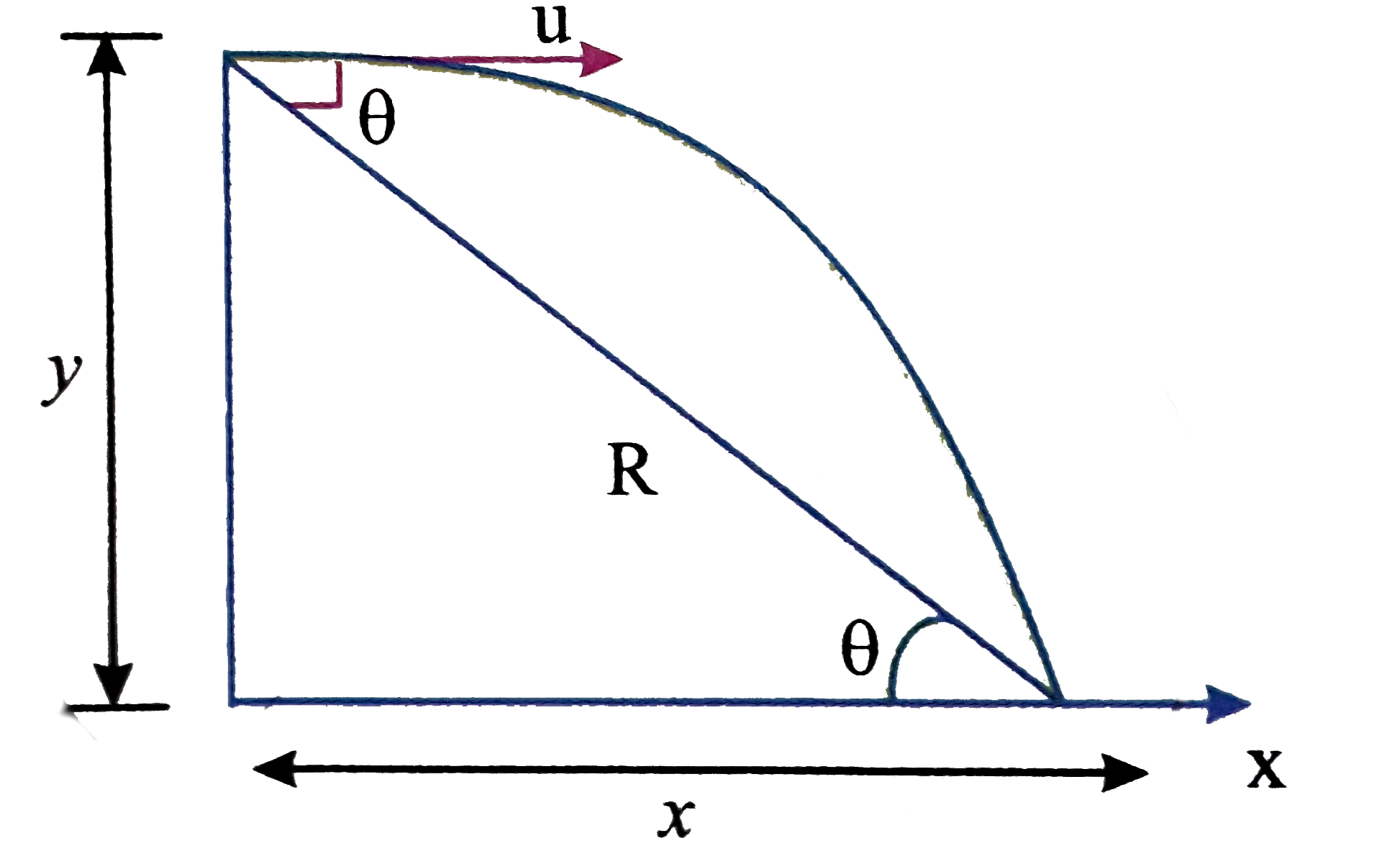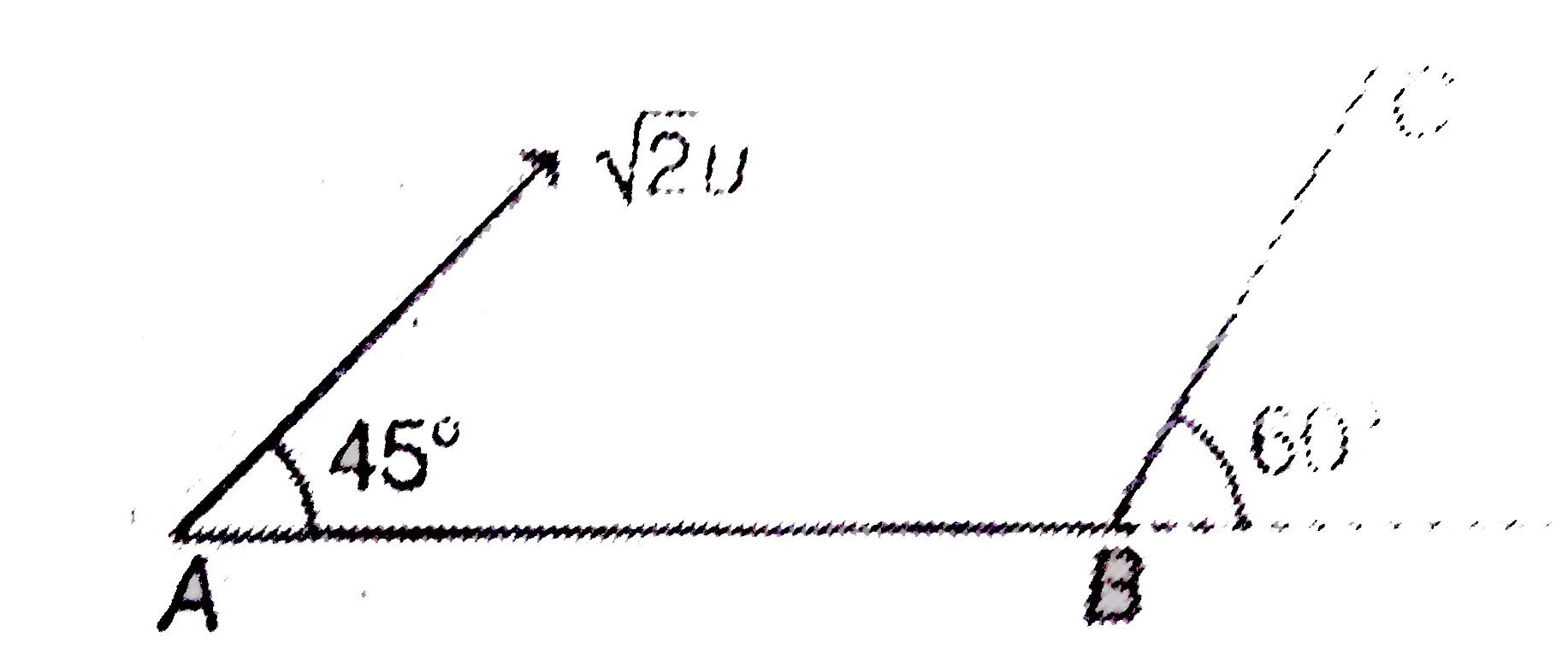A particle is projected at an angle alpha with horizontal from the foot of a plane whoose inclinaiton to horizontal is β. Shwo that is will strike the plane at right angles if , cotβ=2tan(α−β) .
To solve the problem, we need to show that a particle projected at an angle α with the horizontal will strike an inclined plane at an angle β at right angles if cotβ=2tan(α−β).
1. Understanding the Problem:
- A particle is projected from the origin with an initial velocity u at an angle α with the horizontal.
- The inclined plane makes an angle β with the horizontal.
- We need to find the condition under which the particle strikes the plane perpendicularly.
2. Components of Initial Velocity:
- The initial velocity can be broken down into its components:
- ux=ucosα (horizontal component)
- uy=usinα (vertical component)
3. Equations of Motion:
- The equations of motion for the particle under gravity are:
- Horizontal position: x=uxt=ucosα⋅t
- Vertical position: y=uyt−12gt2=usinα⋅t−12gt2
4. Equation of the Inclined Plane:
- The equation of the inclined plane can be expressed as:
- y=xtanβ
5. Finding the Time of Flight:
- The time of flight t until the particle strikes the plane can be derived from the vertical motion. The particle will strike the plane when its vertical position equals the height of the plane:
- usinα⋅t−12gt2=(ucosα⋅t)tanβ
6. Condition for Perpendicular Impact:
- For the particle to strike the plane at right angles, the horizontal component of the velocity at the point of impact must equal zero:
- vx=ucos(α−β)−gsinβ⋅t=0
7. Substituting Time of Flight:
- Substitute the time of flight t from the vertical motion equation into the horizontal motion equation:
- Rearranging gives us ucos(α−β)=gsinβ⋅t
8. Final Condition:
- After simplifying the equations, we arrive at the condition:
- cotβ=2tan(α−β)
Conclusion:
Thus, we have shown that a particle projected at an angle α with the horizontal will strike the inclined plane at right angles if cotβ=2tan(α−β).
- A particle is projected from the origin with an initial velocity u at an angle α with the horizontal.
- The inclined plane makes an angle β with the horizontal.
- We need to find the condition under which the particle strikes the plane perpendicularly.
- The initial velocity can be broken down into its components:
- ux=ucosα (horizontal component)
- uy=usinα (vertical component)
- The equations of motion for the particle under gravity are:
- Horizontal position: x=uxt=ucosα⋅t
- Vertical position: y=uyt−12gt2=usinα⋅t−12gt2
- The equation of the inclined plane can be expressed as:
- y=xtanβ
- The time of flight t until the particle strikes the plane can be derived from the vertical motion. The particle will strike the plane when its vertical position equals the height of the plane:
- usinα⋅t−12gt2=(ucosα⋅t)tanβ
- For the particle to strike the plane at right angles, the horizontal component of the velocity at the point of impact must equal zero:
- vx=ucos(α−β)−gsinβ⋅t=0
- Substitute the time of flight t from the vertical motion equation into the horizontal motion equation:
- Rearranging gives us ucos(α−β)=gsinβ⋅t
- After simplifying the equations, we arrive at the condition:
- cotβ=2tan(α−β)
Thus, we have shown that a particle projected at an angle α with the horizontal will strike the inclined plane at right angles if cotβ=2tan(α−β).
Topper's Solved these Questions
- MOTION IN A PLANEBOOK - AAKASH SERIESCHAPTER - MOTION IN A PLANEEXERCISE - NUMERICAL EXERCISE (LEVEL -2)
19 Videos
- MOTION IN A PLANEBOOK - AAKASH SERIESCHAPTER - MOTION IN A PLANEEXERCISE - EXERCISE-3 (Circular Motion)
7 Videos
- MOTION IN A STRAIGHT LINE BOOK - AAKASH SERIESCHAPTER - MOTION IN A STRAIGHT LINE EXERCISE - very Short answer type question
15 Videos
Similar Questions
A particle is projected with a certain velocity at an angle α above the horizontal from the foot of an inclined plane of inclination 30∘. If the particle strikes the plane normally then α is equal to
View SolutionA particle is projected with a certain velocity at an angle ∝ above the horizontal from the foot of an inclined plane of inclination 30∘. If the particle strikes the plane normally, then ∝ is equal to.
View SolutionA projectile is projected with speed u at an angle of 60∘ with horizontal from the foot of an inclined plane. If the projectile hits the inclined plane horizontally, the range on inclined plane will be.
View SolutionA particle is projected up an inclined plane of inclination β at na elevation ∝ to the horizon. Show that tan∝=cotβ+2tanβ, if the particle strikes the plane at right angles
View SolutionA particle is projected up an inclined plane of inclination β at na elevation ∝ to the horizontal. Show that
(a) tan∝=cotβ+2tanβ, if the particle strikes the plane at right angles
(b) tan∝=2tanβ, if the particle strikes the plane horizontally.
View SolutionA particle is projected horizontally with a speed u from the top of plane inclined at an angle θ with the horizontal. How far from the point of projection will the particle strike the plane ?

View SolutionA particle is projected up an inclines plane. Plane is inclined at an angle θ with horizontal and particle is projected at an angle α with horizontal. If particle strikes the plane horizontally prove that tanα=2tanθ
View Solution(1+tanαtanβ)2+(tanα−tanβ)2=
View SolutionA particle is projected from a point A with velocity √2u an angle of 45∘ with horizontal as shown in figure. It strikes the plane BC at right angles. The velocity of the particle at the time of collision is

View SolutionA particle is projected up an inclined plane of inclination β at an elevation ∝ to the horizontal. Find the ratio between tan∝andtanβ, if the particle strikes the plane horizontally.
View Solution
